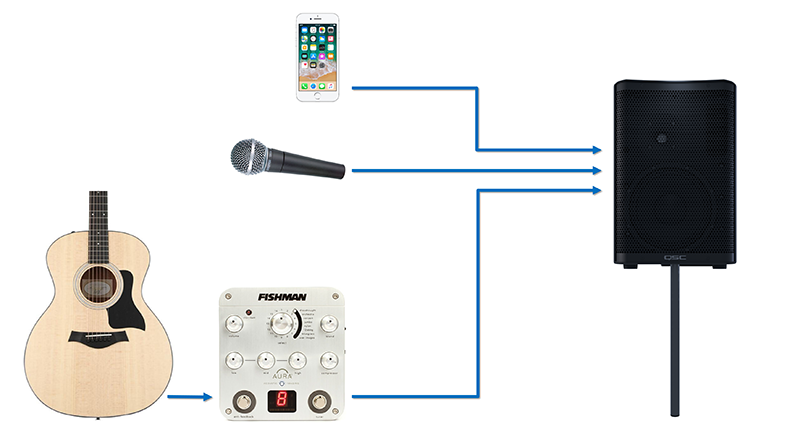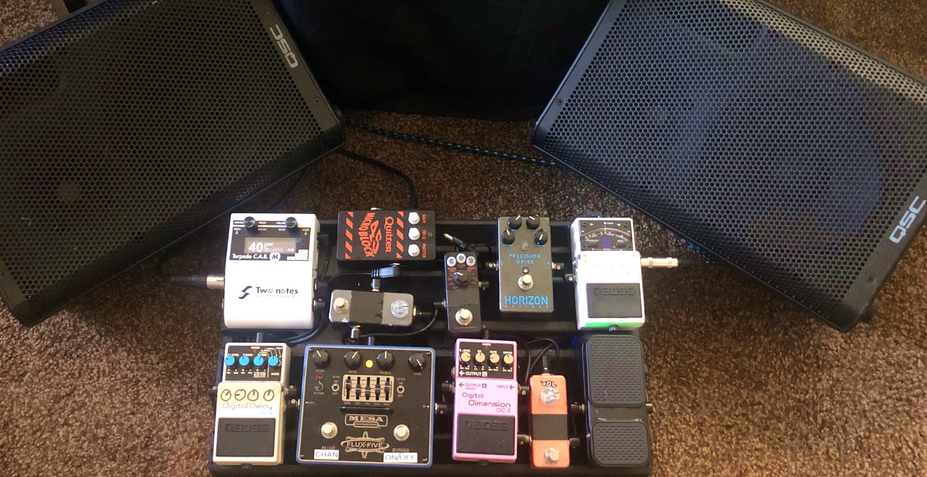Let’s talk electric guitar amplification, for a change. Today’s modeling guitar amplifier processors and pedals are providing an incredible diversity of sounds as well as being simple to operate for both studio and live applications. The technology has allowed guitarists to access a huge collection of amps and achieve tones that would have been otherwise out of reach.
As this technological paradigm evolves, a growing community of guitarists are entrusting their modeled tones to, so-called, FRFR loudspeakers, such as QSC CP Series models.
What is an FRFR Loudspeaker?
FRFR simply stands for full-range, flat-response, which implies that FRFR loudspeakers are able to reproduce any tone or frequencies in a neutral way, emulating the input signal as cleanly and accurately as possible. The FRFR loudspeaker is essentially not adding or subtracting anything from the audio signal it is receiving. Such systems are ideal for modern modelling amps, which contain every option you could imagine for creating the sound you are after.
When choosing an FRFR loudspeaker, remember to consider carefully its ability to reproduce truly a flat response, to handle subtle, as well as large, dynamic changes and to provide ‘live-feel’ with ‘in-room warmth’. Note that electric guitar’s transient peaks can reach levels ten times larger than typical program material. Therefore, having ample headroom is key for any quality FRFR loudspeakers in order to reproduce clean peaks and to avoid deteriorating the original guitar signal.
Guitar Cabinets and FRFR Loudspeakers
On the other hand, standard guitar cabinets still exist. The idea behind all the various cabinet designs (closed-back, open-back, etc.) is that they color your guitar tone in many different ways to create a unique sound. A guitar cabinet also provides an air-pushing presence and its natural frequency response rolls-off towards high frequencies because of both the enclosure design and the inherent transducer’s acoustical characteristics.
In most circumstances, it would defeat the purpose of a modelling amp’s ability to emulate loudspeakers if you were going to connect it to a ‘non-FRFR loudspeaker’, as you would combine different tone colorations together.
PA and FRFR Loudspeakers
Being almost identical, some FRFR loudspeakers differ from PA systems in specific design features, tonal response and user-accessible settings.
Some FRFR loudspeakers aim to re-create the look and feel of traditional guitar cabinet, while others are closer to point-and-shoot PA loudspeakers. In both cases, having on-board EQ and being able to position the loudspeaker as a wedge on the floor, are key criteria for many guitarists.
While most common PA loudspeakers are designed to play loud and have the ability to reproduce all instruments in a band, FRFR loudspeakers aim to be as neutral as possible, as mentioned earlier, in order to provide a ‘blank canvas’ for the sounds produced by the modeling device.
CP Series for Guitar Players
The CP8 and CP12 Compact Powered Loudspeakers deliver stunning audio performance in an incredibly compact package. Featuring a highly efficient 1000 watt power amplifier, CP models are also remarkably lightweight (CP8 is 9.5 kg / 21.0 lb and CP12 is 13.7 kg / 30.1. lb), making them easy to load, carry, lift and deploy on stage or in your studio. Both models include three mixable inputs (Mic, Mic/Line, 3.5 mm Stereo) and a number of DSP contours, including the essential ‘Floor Monitor’ presets highly recommended for FRFR loudspeaker applications.
Note that if no ‘Floor Monitor’ preset is available in your FRFR loudspeaker, the bass response of your rig will be exaggerated. This is occurring because the loudspeaker will be positioned on the floor in a limited radiation space (hemispherical load) and this phenomena will induce a bass boost of up to 6 dB below 200 Hz. Certainly not something you would want for your guitar sound. The ‘Floor Monitor’ preset compensates for that bass boost and allows CP Series to provide a flat frequency response when used in a wedge position.
Last, but not least, CP Series Totes will allow gigging players to carry around their loudspeakers with ease and comfort to and from venues, while CP Series Temporary Weather Cover will protect your loudspeakers during performance in inclement weather.
A few ways to use your CP Series
When it comes to deciding on the best guitar rig, the answer is highly personal, and subjective. However, let’s see the various options you have in using your CP Series as FRFR or PA loudspeakers.
A. Using Guitar Amplifier Modelers
Most modeling guitar amplifier processors feature stereo outputs that can be directly connected to your pair of CP Series used as FRFR loudspeakers, providing a high quality reproduction of your modelled guitar amps. Additionally, CP Series Mix output (post-gain XLR out) can be used to send left and right outputs directly to the FOH mixing console.

B. Using Load Box/Speaker Simulator direct to PA
Another popular rig configuration is to connect a guitar amplifier head to an external Load Box with DSP speaker/transducer simulator (emulating the impedance load and the electrical and acoustical charactersitics of a real guitar speaker in a cabinet). The output of the Load Box is then either directly sent to your CP Series, or sent to the FOH mixing console and to CP Series used as PA loudspeakers.

C. Using Effect Pedals/Cabinet Simulator direct to PA
The next option is to use Effect Pedals without guitar amplifier combined with a Cabinet Simulator (pedal or rack-mounted device) directly connected to either CP Series used as PA loudspeakers, or a CP Series used as personal monitor.

D. Amplifying Acoustic Guitar
For guitar players using electro-acoustic instruments, here is a specific rig configuration. You can send your acoustic guitar output to a Preamp/DI box which is then directly connected to your CP Series used as PA loudspeakers or personal monitor. At the same time – and thanks to the multiple inputs featured on CP Series loudspeakers – you can plug a microphone (via a combo XLR/1/4-inch jack input) and an external audio source (via a separate 3.5 mm stereo input) to your CP Series.
Your stand-alone CP Series is now your personal PA system. Note that you can also daisy-chain up to four CP Series via the Mix Output to cover a wider audience in a large room.

Conclusion
Most guitar players are used to the traditional amplifier/speaker-cabinet setup. Technology moves on and as a result, the FRFR loudspeaker has come into being. When coupled with a quality guitar amp modeler the playing experience is said to be as close to “the real thing” as you can get.
In the audio signal chain – including your guitar rig – the most important element is the loudspeaker, as it will reveal – or not – all the subtleties of your tone. Used as PA system, personal monitor of FRFR loudspeaker, CP Series will provide exceptional audio performance, superior quality and lasting reliability for years of gigs to come.
Good luck in creating your own personal tone! One last thing: if you are using QSC loudspeakers in your guitar rig in a different way than what we have described here, please let us know, we are eager to find out!
Christophe Anet
Latest posts by Christophe Anet (see all)
- History, Development and Applications of Column Loudspeakers - May 30, 2025
- Why is Dynamic Range so important? - May 30, 2023
- Differences between Flown and Floor-Mounted Subwoofer Deployments - May 2, 2023

Hi! I’ve been reading your bⅼog for a ѡhіle now and finally got the courage to go ahead and give you a
shout out from Lubbock Texas! Jᥙst wantеd to say keep up the fantastic work!
Hello, many thanks for your encouraging feedback. I am glad to hear that such info are appreciated and valuable to you. Keep up the music, stay safe and healthy. All the best.
Christophe Anet / QSC Live Sound.
I”ve been using a K10 for FRFM for years with a Fractal AX-8, and more recently with a Torpedo CAB-M that has a traditional pedalboard in front of it. While the K10 doesn’t have the DSP settings that my K12.2 has, it is lightweight and very accurate. I used it with the Ext Sub setting so as to roll off some of the lower frequencies. I’ve done hundreds of gigs with this setup. QSC did a great job designing the original K series – and especially with the new K .2 series.
I have read so many articles or reviews on the
topic of the blogger lovers but this piece of writing is genuinely
a good post, keep it up.
Everyone loves it when people come together and
share opinions. Great website, keep it up!
Qsc k12.2 user owner for years. Great and IMO, best in class. I have recently ventured into modeling. Currently using 1 qsc k10.2 and while it sounds great, I am still learning adjusting the cab block to help with frequencies. Is there and advantage of using a cp 12 vs a k10.2 or other k.2 series? I am considering using the k0.2 to as well as some vocals on the other input. 1st and foremost is the guitar tho. I would switch to the cp12 if that is a better application for guitar modeling. Will just use another monitor for the vocals only. Thanks in advance.
Hello Mike, thanks for sharing your experience and comments. CP Series models are light, simple to install and setup. K.2 Series models offer greater flexibility with on-board EQs and User memories. So, the right choice really depends on your set of requirements. Thanks again for using QSC products. Cheers, Christophe Anet.